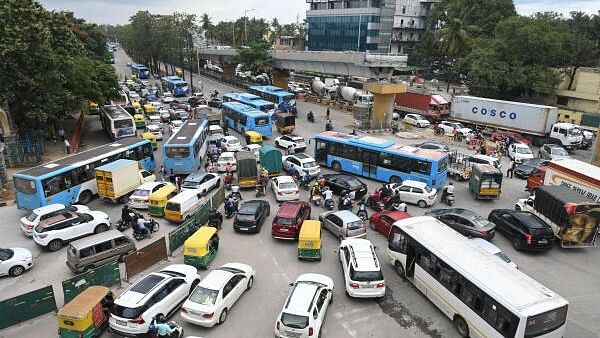
Traffic at Hebbal in Bengaluru.
Credit: DH Photo/B K Janardhan
Bengaluru: Trucks, lorries and other commercial vehicles have been found to be the biggest air polluters of the city with the transport sector accounting for 39 per cent of the lethal particulate matter (PM 2.5) emissions in the Bengaluru Urban district and 48 per cent in the BBMP area, followed by industries which continue to burn wood and coal despite availability of less polluting alternative fuels, a new study has revealed.
Led by Prof Gufran Beig, School of Natural Sciences and Engineering, National Institute of Advanced Studies, researchers worked for several months to develop accurate emission inventories if 200 square metre grids of PM 2.5 and the larger particulate matter (PM 10) in Bengaluru Urban district. "In a first, we have identified 80 pollution hotspots of ultra fine resolution (200 sqm grids). What we see here is a snapshot of the major sources of pollution. We find that transport sector is the biggest polluter," Beig said.
Researchers adopted a hybrid model where field data, CCTV camera footage as well as photo and video clips from drones were analysed with artificial intelligence and macine learning tools. The results painted a stark picture of Bengaluru's air quality.
"We see that commercial vehicles which make up just 4 per cent of a road fleet account for half of all the PM 2.5 emissions from the transport sector. This may be due to the poor maintenance of the vehicles or age of the vehicles. Cars and SUVs form 22 per cent of the fleet and account for 22 per cent. A whopping 70 per cent of the vehicles on the road are two wheelers. Though their direct contribution to PM 2.5 is low, these vehicles cause stall traffic by breaking the flow and cause higher emission by other vehicles," Beig explained.
Ban on wood, coal as fuel
The study said industrial pollution was driven by the choice of fuel in the boilers. Industries emitted 24 per cent of overall PM 2.5 mainly due to the burning of wood and coal by 19 per cent of the industries in the district. This also led to the high emission of PM 10.
A majority of the industries (27 per cent) used diesel, followed by electricity (25 per cent) and wood (19 per cent). "This reliance on fossil fuels like diesel and wood highlights the potentioal for emissions reduction through the adoption of cleaner energy sources," the study said
Of the 113.6 giga tonne per year of PM 10, dust accounted for 40 per cent followed by transport (24 per cent), industries (17 per cent) with the remaining shared by generators and other sources.
Need enforcement
Beig said enforcing the norms for commercial vehicles and streamlining traffic movement by segregation of vehicles, last-mile connectivity with seamless ticketing option, reducing metro fares and total ban on burning of wood in industries were some of the mitigation measures.
Director General of Environment Management Policy Research Institute (EMPRI) B P Ravi said many of the measures suggested by the study were low-hanging fruits.
"The study has some crucial pointers for policy making. Some of these solutions are easy to adopt. However, any change can happen only when all line departments are involved. At the same time, the findings need to be disseminated among the public to make them stakeholders," he said.